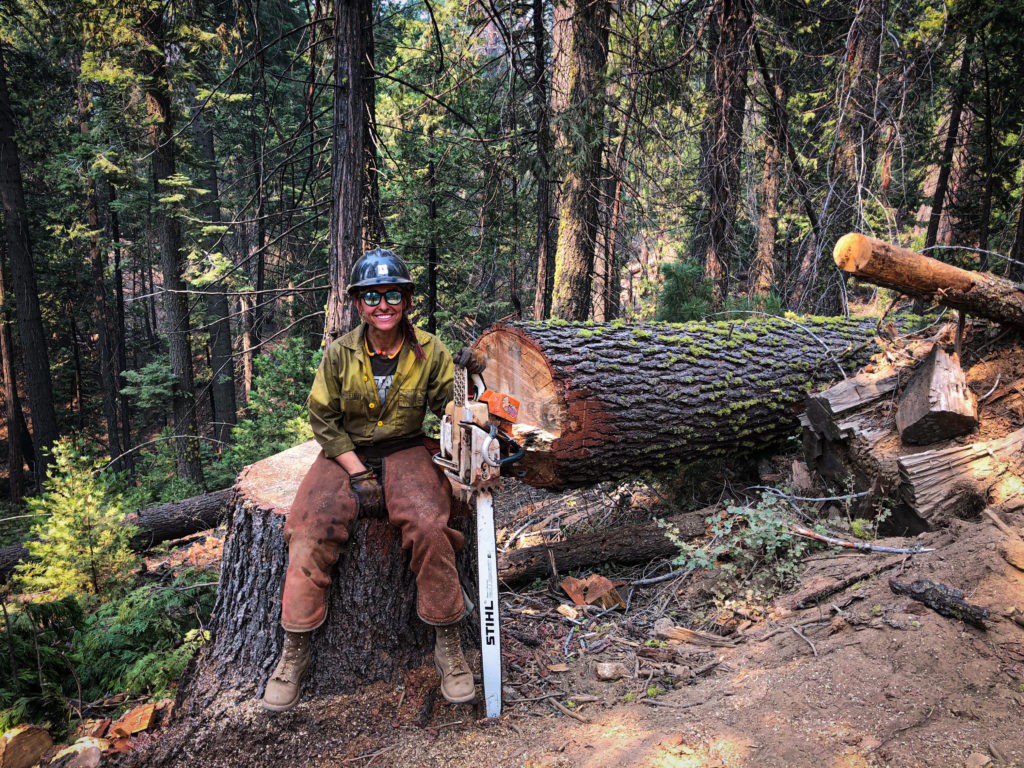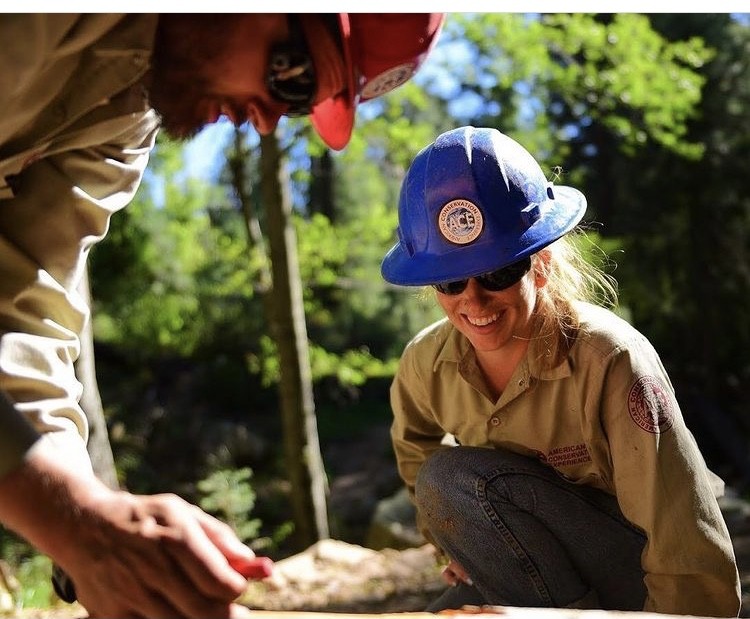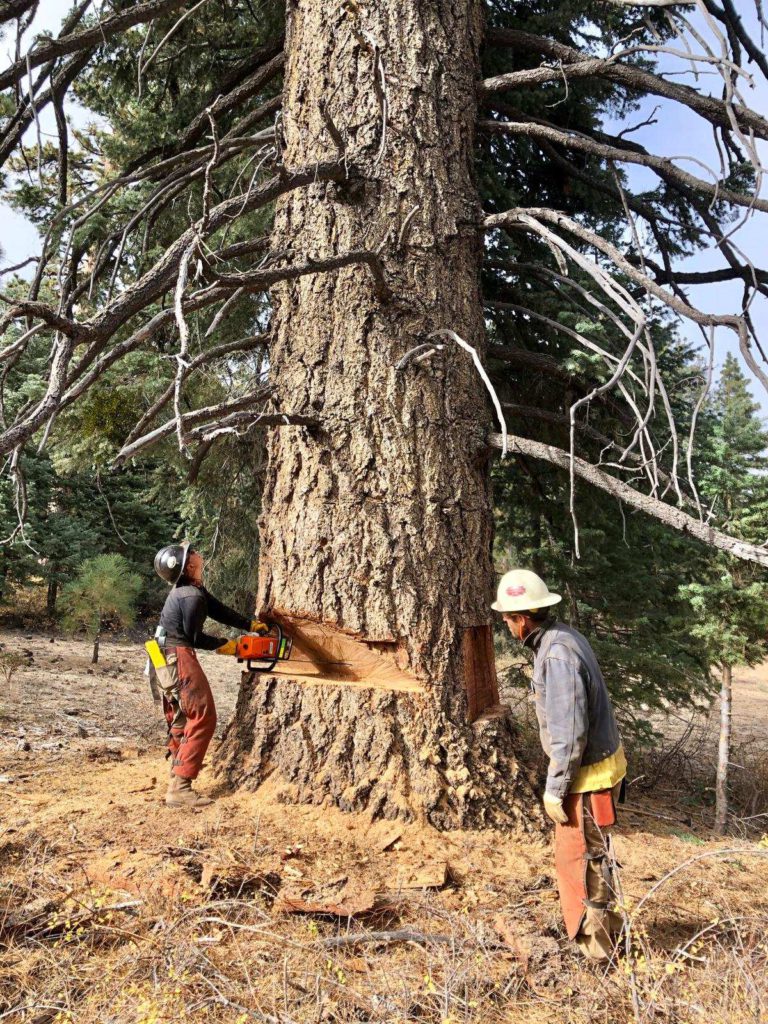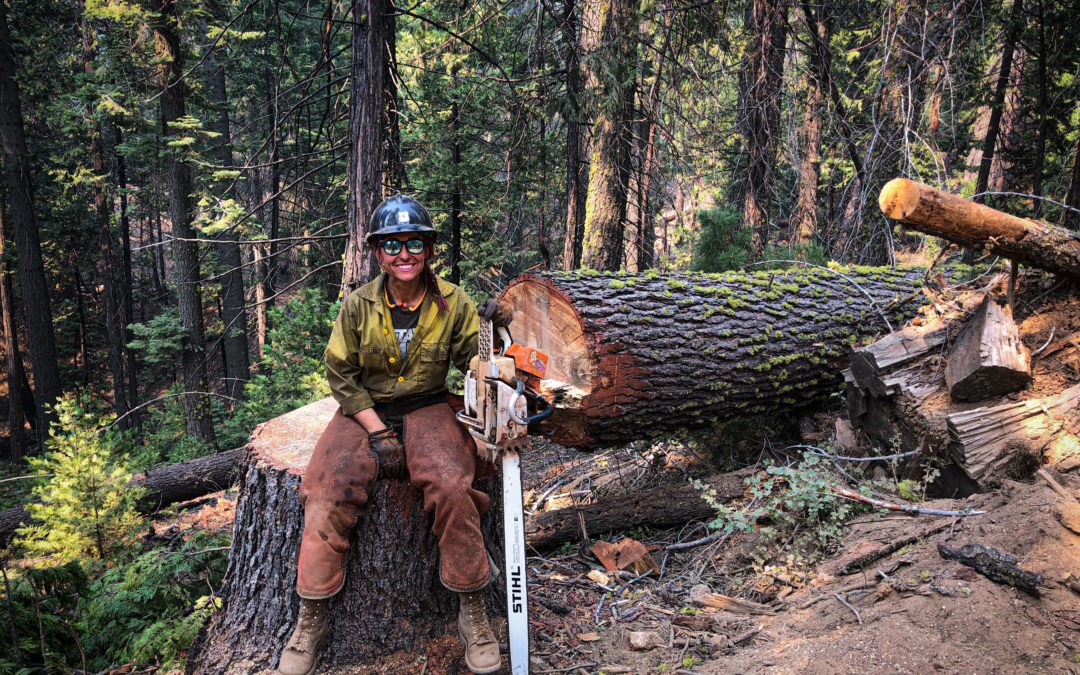Written By : Maggie Weaver
Today, tree felling is relevant for three primary reasons: logging, landscaping, and fighting fire. How do women factor into these industries, particularly logging and firefighting, and how has their involvement in these fields changed over time?
How is it that Microsoft Word’s spell check considers Lumberjack a proper noun, yet does not even consider lumberjill a word? Or that Lumberjack has its own entire page on Wikipedia, yet the only entry for lumberjill is a page about the Simpsons “Marge the Lumberjill” episode? Try searching ‘lumberjill’ on Google—you get a scanty four links related to felling trees before Google thinks you must be mistaken and are looking for a ‘lumber mill’. Results are even worse with a search for ‘female loggers’: the first link that comes up is how top female bloggers are making money from blogs. Historically, women tree fellers were a rarity—even an oddity—and while they have grown a lot in strength and prevalence over the years, even today they are still viewed as extraordinary and uncommon when compared to their male counterparts.

A feller is, according to the Free Dictionary, “a person who fells trees: a faller, logger, lumberjack, or lumberman laborer”. Already this current definition leaves little to no room for women. Wikipedia’s entry on Lumberjacks enforces the male stereotype, stating that “the men built a traditional culture that celebrated strength, masculinity, confrontation with danger, and resistance to modernization”. Lumberjacks have been around for a while—records date back to the early 19th century, and there is a fair amount of such records and accounts. Unfortunately, neither lumberjills nor their records were as prevalent as their male counterparts and their records. Isn’t is so ironic, then, that the chainsaw was originally invented for women? The first chainsaw, designed in 1830 by German orthopedist Bernhard Heine, was actually intended to help with childbirth. Heine called his creation the ‘Osteotome,’ which literally means ‘bone cutter,’ and the saw was used to help with procedures for obstructions or breech during the birthing process (this was before the caesarian section was developed as a method). A little less than a century later, the electric chainsaw was invented, and, in 1959, Husqvarna released its first saw. However, well past 1959, women were still fighting for recognition in the felling industry. The following accounts highlight a brief history of women fellers from the 20th century to present day.
The Forgotten Army of the Woods
One reason to fell trees is for the logging industry—timber harvests are manufactured into products such as firewood or building material. While there are not many historical accounts of women loggers, there is one notable record: that of the Women’s Timber Corps (WTC) during World War II. The Corps Women (approximately 6,000 lumberjills whom the New York Times deems “Rosie the Riveter’s British Cousins”) comprised a very small, top-tier group that took over for the lumberjacks fighting on the frontlines. The women surveyed, felled, and processed Britain’s timber into crucial commodities for the war effort, including telegraph poles, rails, and coal mine infrastructure. Historian Emma Vickers tells the story of the Corps in her document “The Forgotten Army of the Woods”. It unfortunately took several years after the war’s start to even establish a separate service for women within the Forestry Commission—it wasn’t until April of 1942 that the WTC was officially founded, as the tasks were previously deemed to be “no job for a woman”. Rosie the Riveter’s cousins soon proved this conclusion wrong, however.
Vickers notes that “despite the Forestry Commission’s prediction that women would largely be confined to lighter jobs like planting, women fellers played a crucial part in activities of the organization”. The ladies took on all ‘timber tasks,’ even felling, the hardest job of all. As this was pre-chainsaw times, the women wielded axes weighing up to seven pounds, and worked in pairs to crosscut trees up to 80 feet in height. Vickers even calls attention to a Scottish Forestry Journal account that lumberjills during this time were just as capable as men at felling trees and handling axes. Unfortunately, Vickers also recounts that “despite the remarkable job undertaken by the WTC, the organization has received relatively little attention in the histories of the Second World War”. It is largely thanks to Vickers’s “Forgotten Army” account that the WTC legacy lives on today.
The Toughest, the Baddest, and the Best
“This culture [wildland firefighting], where there is pressure to be the toughest, the baddest and the best, wasn’t an easy one for women to break into,” writes James Lewis in his article “‘New Faces, Same Old Values’: Revisiting a History of Attitudes Towards Women in the Forest Service”. In addition to timber harvest, wildland firefighting is another aspect of tree felling: trees are cut down to thin/reduce the overall forest density so that fires may burn in a safe and ecologically beneficial way for sustained forest health. Wildland firefighting is no easy job—one must be of utmost physical fitness, and must pass a work capacity test that requires carrying a 45-pound pack for three miles in 45 minutes or less. Such is why this field is not as historically common for women—just as the Timber Corps was originally deemed too physically difficult for women, wildland firefighting was originally viewed in the same light. Lewis remarks that “women—and minorities too—have almost always struggled to be seen as peers and equals in the Forest Service, particularly in the timber and fire management areas, which traditionally have been the domain of white males”.
There are, however, still records of women wildland firefighters that date back to the early 20th century. The first account is in 1915, when Forest Service Rangers’ wives helped mitigate CA forest fires. Alex Potter details this account and more in her National Geographic article “The women battling wildfires and breaking barriers in the American wilderness”. According to Potter, while all-female wildland fire crews were around in CA as early as 1942, it was not until the 1970s that women were actually paid by the Forest Service for fire suppression and were on most types of fire crews. Moreover, even as women became more prevalent in the field, they still had to fight for their rights and credentials. In 1979, research sociologist Gene Bernardi sued the forest service for gender discrimination in their hiring process; they did not hire her as they were waiting for a male candidate instead. After her class action suit, Gene was given compensation as well as a classification raise, and the Forest Service created a consent decree mandating equal job access to all USFS agency positions. Today, the Forest Service continues to work towards decreasing the male-female ratio in wildland firefighting, and in confronting the stereotype that the work is for males. While the percentage of women in wildfire jobs is still small—Potter cites that women make up about 12% of all wildland firefighters—she also highlights that their numbers continue to grow, expressing that “these women are driving change in the male-dominated forest service”.
To ACE and Beyond: Stories from Today’s Women Fellers
Today, there are opportunities for women in all areas of felling, including as arborists, loggers, forest thinners, and wildland hotshots, among others. ACE offers ample opportunities for women to become involved in felling through its chainsaw training programs. The programs offer not only USFS ‘A Feller’ certification, but also training in chainsaw maintenance and in crosscutting. Former ACE Sawyers Kat Dickey and Olivia Gagliardi, both of whose first introductions to felling were through ACE, note that in their experiences, chainsawing in ACE has been female-dominated. Both sawyers were trained by women and came to ACE at times when the saw shop was run by women. The following interviews recount their felling stories and experiences.
Kat Dickey

[When I came to ACE last year as a new 900-hr. Corps Member for chainsaw training, Kat was the project manager for all things saw-related. My first impression of Kat was that she was an incredibly knowledgeable and capable sawyer: one who was quite confident in her abilities to both lead and teach. It was clear to me that she loved chainsaws and moreover loved being in the field all day using them—her eyes lit up every time I came to her with a saw problem, and she took on each maintenance issue as if it was a fun riddle or puzzle to be solved. There was never an issue that she couldn’t handle, too.
I was very impressed by her felling skills: my male sawyer instructor for my small group did not even hesitate to admit to me that Kat was a better sawyer than he was, and probably the best sawyer there out of all the instructors. Finally, I remember that Kat always seemed to have perfectly done red nails, which I thought was badass—wielding chainsaws and axes to cut down trees, all while rocking glamorous red nails, is truly an impressive feat! Although I was a far-from-competent sawyer when I started my training under Kat’s supervision, she gave me the reassurance I needed to slowly grow and develop my technical skills. I owe a lot of my confidence in the field as a female sawyer to Kat and the inspiring example she set for me].
Q: Where did you learn to saw and what was that initial experience like?
A: I trained through ACE but I actually didn’t get trained until I was a crew leader. I honestly did not think I would like chainsawing when I first started at ACE—I was pretty nervous and when I was given the choice between a 900-hour term with trails or chainsaw training, I chose trails. I came to ACE right out of college, after having studied political science. So I didn’t really envision myself working with power tools. But later on when I became a crew lead, ACE needed someone to lead a chainsaw project. I soon got trained one-on-one, sort of like a “tutoring session,” and then led the thinning project the first year ACE did it.
I didn’t really have time to be nervous during my training, since it was a rapid transition. As such, I missed the time period of development where I could make mistakes and have someone to correct me, because immediately after my training I led a saw project. That first saw project was a brushing project and the entire crew except for one other person had also just gotten trained on the chainsaw. From that first leading experience with saws, I quickly saw how much of a learning curve there is—all of my saws flooded and I had to call the office for help! I essentially spent a lot of time in the troubleshooting guide and calling other project partners to figure out what was going on that first project. But as time went on, this ended up being part of the satisfaction with sawing: having control in my life to be able to teach myself skills that I would have guessed would have been so far outside of my comfort zone.
Q: How did your chainsaw experience progress and where did it ultimately lead you?
A: My path with sawing has been somewhat accidental and I’m very happy about it. As I mentioned, I didn’t receive the training as a Corps Member—it was not until I became a crew lead that I became a certified sawyer. Up until the thinning project, I did a lot of corridor clearing and brushing. After over a year of crew leading, I got hired on as a project manager. Initially it was to manage Tonto National forest projects (mostly trail work)—it wasn’t until later that I began to manage thinning projects. So, my first year as a project manager, I spent a lot of time teaching myself how to deal with trail tools. But then when my coworker who had been managing the saw shop moved on to a different position, I stepped in and slowly slid back into the world of chainsaw operation and maintenance.

Q: Did you feel any effects of chainsawing being a male-dominated field while you were in ACE?
A: Not really—when I first came to ACE the saw shop was run by women (which I thought was really cool), and actually all the people I learned saw skills from in ACE have been women. I think, however, that when you move out of that conservation space in ACE you do start getting into the more male-dominated side of things. I know women wildland firefighters who have had seasons being the only woman on their crew or only one of two women on their crew. ACE is definitely a good place to start chainsawing, to gain that confidence before getting to the forest service or somewhere where the ratio starts to dip dramatically.
There were a few instances where a project partner would teach something that was not necessarily along the same lines as what I would teach, or questioned a call that I made. I have felt in certain cases too, that I had to work harder to justify my technical knowledge. I really don’t know, though, if it was the fact that I seemed younger, or my gender. Regardless, ACE luckily gave me a lot of confidence in my saw skills and in my ability to train others to develop the same skills. So, I was very comfortable with making calls and telling people that it was my decision to teach skills a certain way.
Q: What is your favorite thing about chain sawing?
A: I don’t think I would have stayed at ACE as long as I did without the saw training. Learning how to saw and how to fix saws really developed my skill set in ways that were more challenging and interesting to me. I put myself in that niche, and really enjoyed it. Maintenance especially was the skill set that I didn’t expect to learn or like, but it actually ended up being one of my favorite parts about sawing. I had no interest in Legos or really any mechanical sort of thing as a kid so it was something that took me by surprise. I learned a lot of my saw upkeep from other women in the saw shop, but also from YouTube videos; it turned out that I loved trying to figure out what was going wrong and why.
Olivia Gagliardi

Q: Where did you learn to saw and what was that initial experience like?
A: I learned when I was a Corps Member at ACE in 2014. It was definitely an exciting experience. Even though I hadn’t ever used one, I remember not being super intimidated by it because I had helped my dad with carpentry and yard work while growing up and got used to using power tools with him (Lawnmowers, electric drills, staple guns, snow blowers, etc.). If I remember correctly, there were 2 of us women and maybe 5 or 6 guys as students. What was really cool, however, is that the saw program at the time was run by 2 women, Afton and Marieke. I remember thinking they were some of the most badass women I had ever met.
Q: How did your chainsaw experience progress and where did it ultimately lead you?
A: Using the saw was definitely a frustrating experience at the beginning. Shortly after I got trained I was put on a month-long project on the Bitterlake Wildlife Refuge in New Mexico cutting salt cedar. I felt like if there was any feasible mistake to make, I had made it—I dirted/rocked my chain a ton, stretched 2 chains and snapped a third, broke a bar tip from getting it pinched, and even sliced my thumb open from filing my bar without gloves on! I remember being incredibly upset with myself; I felt as though my mistakes were making it harder on my crew leader and causing us to not get as much work done. I actually came back to ACE from that project and told Afton I didn’t want to cut anymore because I had made so many mistakes. She told me that she believed in my ability to continue cutting and that I wasn’t done learning because I wasn’t done living. That motivated me to keep doing it and eventually I was a crew leader leading mostly restoration/chainsaw projects. That set me up very well to transition into wildland firefighting because I had to develop the skills to fell trees, cut in the brush, and maintain/troubleshoot saws. After I led a chainsaw/restoration crew for AZCC in 2017 I felt ready to challenge myself even more and gain new skills, which is what led me to apply for fire.

Q: What does a typical day look like with wildland firefighting? How much saw time do you get?
A: If we are on a fire, a typical day might look like prepping a road or line for us or another crew to burn later. When prepping, we take down any snags that might fall on the line, and remove brush along the line that could potentially throw spots during the burn. Other days, we might be hot spot-cold trailing. This is when we have the fire contained (line all the way around and the forward progression has stopped) and we are walking around the edge to seek out heat and cool it down. We cool it down either with water, by cutting out brush/trees (limbing a tree to access the heat underneath, or felling a tree that has heat in it), or by digging it out and exposing it to air. It allows us to secure the edge of the fire and hopefully prevent it from spotting over our line. As far as saw time goes, it could just be for a few hours or as long as a full day of cutting/prepping line.
Q: Did you feel any effects of chainsawing being a male-dominated field while you were in ACE?
A: I didn’t feel that as much when I was in ACE, which was probably in part because the program was run by women and it was pretty equal as far as the men-women ratio in ACE went at that time. I do remember once or twice advocating for myself on a saw project to be able to take down some more complicated trees. The crew leader was a male in both instances and I think it was just their natural inclination, due to social/cultural norms, to turn to the guys on the crew first. I have been on a saw since my rookie season with my crew, Flagstaff Hotshots, and feel that I was able to gain respect for my ability to run a saw and work hard.

I still feel the pressure at times to do a good job not just for the sake of doing good work but also showing that women can run a saw and work in fire as well. I do feel supported by my crew however, and received my B this year which was my biggest goal. The unfortunate truth is that there is a lower bar set for women being able to run a saw or work in fire—sometimes it feels as though people are impressed by the fact that I can even turn it on or buck up a simple log. I have talked with other women in fire who have experienced the same comments or feelings. So there is definitely a certain amount of pressure I feel to not mess up and put this idea in people’s heads that “women can’t do this job”. I have been trying to not get as consumed by that as much as I did my first season, however, because it can turn into a feedback loop pretty quickly. I think overall I feel it more working in fire than I did in the conservation corps, simply because there are fewer women in the field still and even fewer running saws.
Q: What is your favorite thing about chainsawing?
A: I love the puzzle aspect to it. Whether it is cutting in the brush and figuring out the best way to move through it so that my saw partner and I can work efficiently, or figuring out how to safely and effectively take down a tree the direction I want it to go, there is much more thought to it than simply pressing the trigger. Troubleshooting a saw that isn’t working properly also taps into the problem solving side of my brain and can be so much fun (albeit at times terribly frustrating) to figure out what is wrong and actually get it to work again.
Final Thoughts: Cracking the Stereotype Further through Sports
Felling practices and tools have come a long way since the first “bone cutter” in 1830, and so have the women who use them. Just as today’s women carry on the WTC legacy and drive change in the male-dominated world of wildland firefighting, they further enhance the legacy by giving lumberjills a name as professional competitors alongside lumberjacks. Two notable instances are in 1995, when Tina Scheer founded the first all-female group of logging sports entertainers, and, more recently, when the first Timbersport’s Series Women’s Division competition arrived in 2017 (32 years after the dawn of the sport). Thus, both in celebrating Women’s History Month 2021 and in moving forward, it will be exciting to see how these female fellers—truly the toughest, the baddest, and the best—continue to break down stereotypes and assert their rightful place as successful loggers, conservationists, wildland firefighters, and professional athletes alongside their male counterparts.

